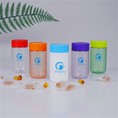PP vs PET Bottles - Which Is Better for Health Supplement Packaging?
In the supplement industry, packaging isn't something you can choose casually. Each formula has its own stability needs - some are moisture-sensitive, others are light-sensitive, and many depend heavily on good sealing.
That means the bottle material directly affects product quality and shelf life.
From our experience as a manufacturer working with global buyers, one of the most common questions we hear is:
"Should I use PP or PET bottles?"
Both are safe, globally available, and cost-efficient materials, but they perform differently in key areas.
Let's go through what really matters from a buyer's point of view.
1. Appearance: Transparency vs. a Professional Look
PET's transparency is its biggest advantage.
It delivers a clear, glass-like appearance that showcases capsules, softgels, or tablets beautifully. That's why many nutrition brands, especially in North America and Europe, favor PET bottles.
PP bottles, on the other hand, are usually semi-transparent or milky white.
They give off a more medical, pharmaceutical feel, making them ideal for formulas that need light protection, such as probiotics or other light-sensitive ingredients.
Quick summary:
Want a clear, glossy display? → Choose PET
Need light protection or a more "clinical" look? → Go with PP
2. Material Properties: Heat Resistance & Chemical Stability
When it comes to temperature, the difference is clear:
PP bottles handle heat much better.
They can withstand higher temperatures, making them suitable for hot-fill or sterilization processes required in some regions. PP also offers stronger chemical resistance.
PET performs best at normal temperatures.
It's not designed for high heat or direct sunlight, but it holds up perfectly in everyday storage and transportation.
If your product requires higher stability or temperature tolerance, PP is generally the safer choice.
3. Airtightness & Barrier Performance
A common misconception is that "thicker bottles seal better."
In reality, what matters most is the material's barrier capability.
PET has stronger oxygen and moisture barrier properties,
which makes it ideal for capsules, coated tablets, and products sensitive to humidity.
PP has slightly weaker barrier performance,
but with the right closure - such as an aluminum foil seal or pressure-sensitive liner - it can still deliver excellent sealing for long-term storage.
If your supplement is moisture-sensitive, PET bottles usually provide better protection.

4. Strength & Impact Resistance
Both materials perform well during export and logistics:
PET: Lightweight yet strong, excellent resistance to impact and compression.
PP: More flexible, less likely to crack if dropped.
In real-world transport, there's not much difference between the two.

5. Which Is More Suitable for Your Supplements?
PET is the better choice when:
You pack softgels, hard capsules, or coated tablets
You want a transparent, premium look
You target U.S. or European markets
You need strong moisture and oxygen barrier protection
PP is the better choice when:
Your formula is light-sensitive (like probiotics)
You require heat resistance or sterilization
You prefer a medical-grade appearance
You're optimizing for lower cost
Many factories - including professional bottle manufacturers and plastic packaging suppliers - produce both PP and PET versions so buyers can choose based on formula and market needs.
6. Final Thoughts: It's Not About "Better," It's About "Right"
From a manufacturer's point of view, both PP and PET are reliable, food-grade materials that meet international safety standards like FDA and ISO.
They each have well-developed global supply chains, consistent quality, and proven durability in long-distance shipping.
Your best choice depends on your product type, target market, packaging style, and logistics conditions.
If you're still unsure which material fits your supplement line, consult your plastic bottle supplier or factory - experienced manufacturers can easily recommend the most practical solution based on your formula and distribution plan.





